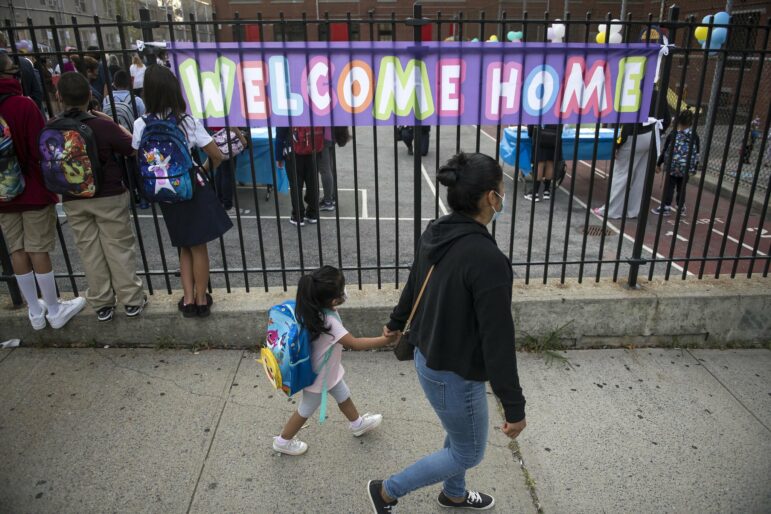“When schools take collective ‘ownership’ of chronically absent children and commit to finding out why they’re not in school, it makes a difference.”

Ed Reed/Mayoral Photography Office
A scene from the first day of school in New York City in 2021.It is a truism that it is hard for students to learn in school if they are not there. The pandemic lockdowns exposed just how true this is, with higher absenteeism and learning rate losses. Fortunately, an absenteeism solution may be emerging.
Many months of not attending school in person (and the legitimate reasons behind that) seems to have lessened the importance of in-person attendance for some. (As an aside, teacher absenteeism is an issue as well nationwide.) And yet the stark statistics on pandemic learning loss—and the apparent links to absenteeism—illustrate that the slogan about showing up being half the battle has some truth behind it.
More than half of the city’s 12th graders missed at least 10 percent of the school year, the definition of chronically absent. Chronic absenteeism was 12 percentage points lower before the pandemic—and that already exceeded the national average. One analysis of the National Assessment of Education Progress, known as the national report card, tied learning loss to absenteeism.
Both teachers and school leaders are concerned, of course. With so much on teachers’ plates, teacher burnout high, the added work to turn around attendance rates feels like yet another straw on their proverbial backs. Teaching Matters has worked in close partnership with our educator teams to get under the hood of what is going on with our children. We have seen some promising results.
There are a range of reasons why children are missing school. But together teacher teams and attendance teams asked how we could create environments that really got to know our students, figured out individual challenges they faced and made connections with their families to increase their sense of belonging. Schools also created incentives, creating reward systems that acknowledged and celebrated students.
When schools take collective “ownership” of chronically absent children and commit to finding out why they’re not in school, it makes a difference. The schools that were most effective usually had an attendance team, which typically includes a dedicated attendance teacher, a social worker and a parent coordinator. In this way, these schools galvanized the staff who work outside of classrooms to take the lead, lessening the burden on classroom teachers. These teams notice who is chronically late and dig into the reasons for it. They make efforts to really educate families on the importance of attendance. Sometimes parents aren’t aware of the educational effects of chronic absenteeism, and things change when they find out.
This culture of attendance could include visiting those students and their parents to find out whether they feel isolated, and why. For example, in our organization’s Network for School Improvement—a five-year pilot program funded by the Gates Foundation that supports 16 city middle schools—some schools developed a success mentoring program for a student who is absent 10 percent of the time, in which the student meets regularly with a mentor or another student.
For kids absent even more often, our teams went further. For example, we often found that when children were absent the most it was due to living in distant shelters that made it difficult to get to school on time. Teams worked on ways to solve those transportation and other issues in partnership with the student and their family.
One city school, K162 in Brooklyn, is an example of how to do it right. It sets a 95 percent attendance minimum, and communicates clearly with parents about what absenteeism means and how it will be handled. The school’s attendance team contacts parents, often in person. Students who improve their attendance are celebrated in school and parents are contacted again to let them know about their children’s improvement. The school holds itself accountable with a detailed attendance tracker that includes data on individual students’ attendance trends and, importantly, which attendance team staff member is responsible for each child.
The results were not subtle. Chronic absenteeism had been as high as 28 percent before 2019. But since adopting these and other practices, the school’s chronic absenteeism declined each year —including during the pandemic—to 14 percent.
Other school districts have taken similar steps. Connecticut spent almost $10.7 million of its federal pandemic relief money to build a home-visit program, and in just six months saw attendance jump by 15 percentage points. The program built and strengthened relationships between families and schools. Los Angeles and New Mexico have seen results from helping kids who deal with homelessness or mental health challenges navigate those issues better.
The common denominator in these approaches is that successful schools avoid punishing children for poor attendance—which only creates more absenteeism—and instead look for and address the problems behind poor attendance.
In the end, children want to belong. They want to succeed and they want to connect, and their parents want that for them, too. Thanks to the lockdowns, we know better about what prevents that. So instead of ostracizing those students further, let’s find ways to invite them in and help them learn and grow together.
Lynette Guastaferro is CEO of Teaching Matters, a nonprofit that helps teachers work more effectively. Jacobē Bell, network director for Teaching Matters, is an experienced coach for teachers and school administrators.








